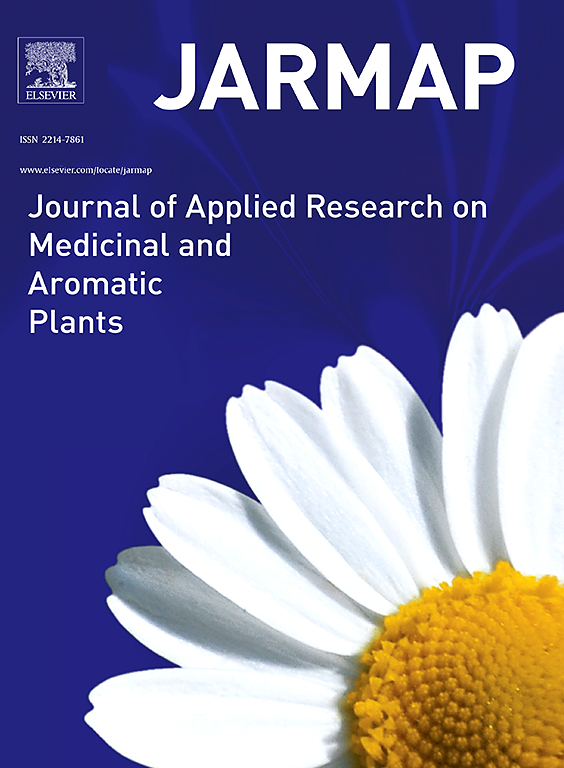Effect of salinity and temperature on germination and post germination of Anabasis articulata (Forssk.) Moq. (Amaranthaceae): An important salt tolerant plant in Algeria
IF 3.6
2区 农林科学
Q1 PLANT SCIENCES
Journal of Applied Research on Medicinal and Aromatic Plants
Pub Date : 2024-12-27
DOI:10.1016/j.jarmap.2024.100619
引用次数: 0
Abstract
Anabasis articulata, a medicinal plant used in Algeria to treat various ailments, also has significant pastoral and ecological value. Assessing its tolerance to temperature changes and soil salinity is crucial for understanding its potential use in the restoration of salt-affected lands in dry and semi-arid regions. The objectives of the present work were to determine the optimal temperature for seed germination of an important medicinal species and evaluate the degree of tolerance to saline and thermal stresses during germination and early seedling stages of Anabasis articulata. Seeds were collected from individuals of two populations of Anabasis articulata located in Sed Rahal (Djelfa-Algeria) and Oued N’sa (Ouargla-Algeria). Seeds were germinated at seven salinity levels (0, 100, 200, 300, 400, 500, and 600 mM) and incubated at eight temperatures (5,10, 15, 20, 25, 30, 35, 40, and 45°C). The germination attributes studied were germination kinetics, germination percentage, germination rate, and the measurement of shoot and root lengths of seedlings. The statistical analysis revealed that salinity level and temperature variations significantly affected germination and post-germination characteristics. The highest germination percentages were obtained under non-saline conditions; salt stress delayed or limited the germination process and seedling growth. High temperatures (35–45°C) have a more negative effect than lower temperatures (5–15°C). Optimum temperatures range from 20 to 30°C. At these temperatures, even at a saline concentration of 600 mM, 46 % of the seeds were able to germinate for the Sed Rahal station and 21 % for the Oued N’sa station. Sed Rahal exhibited higher final germination percentages, germination rates, and seedling growth compared to Oued N’sa, particularly under moderate temperatures and lower salinity levels, demonstrating better resilience to salinity and temperature extremes. Sed Rahal seedlings exhibited more reduction in root length at low temperatures, while Oued N’sa seedlings showed more reduction in shoot length at high temperatures. The results demonstrate that this species possesses significant ecological adaptation in germination and seedling stages, making it suitable for the restoration of damaged ecosystems and marginal areas.
盐度和温度对竹叶重根发芽和萌发后的影响Moq。(苋科):阿尔及利亚重要的耐盐植物
在阿尔及利亚用于治疗各种疾病的一种药用植物,也具有重要的畜牧和生态价值。评估其对温度变化和土壤盐度的耐受性对于了解其在干旱和半干旱地区受盐影响的土地恢复中的潜在用途至关重要。本研究的目的是确定一种重要药用植物种子萌发的最佳温度,并评价其萌发和幼苗早期对盐胁迫和热胁迫的耐受程度。在阿尔及利亚杰尔法的Sed Rahal和阿尔及利亚瓦尔格拉的Oued N 'sa两个居群中采集了Anabasis articulata的种子。种子在7种盐度水平(0、100、200、300、400、500和600 mM)下发芽,并在8种温度(5、10、15、20、25、30、35、40和45℃)下孵育。研究了发芽动力学、发芽率、发芽率以及幼苗的茎长和根长。统计分析表明,盐度和温度变化对发芽和萌发后性状有显著影响。无盐条件下发芽率最高;盐胁迫延缓或限制了种子萌发过程和幼苗生长。高温(35-45°C)比低温(5-15°C)的负面影响更大。最佳温度范围为20 ~ 30°C。在这样的温度下,即使盐浓度为600 mM, Sed Rahal站的46 %种子能够发芽,Oued N 'sa站的21 %种子能够发芽。与Oued N 'sa相比,Sed Rahal表现出更高的最终发芽率、发芽率和幼苗生长,特别是在中等温度和较低盐度水平下,表现出更好的盐度和温度极端应变能力。Sed Rahal幼苗在低温下根长减少较多,而Oued N 'sa幼苗在高温下茎长减少较多。结果表明,该树种在萌芽期和苗期具有较强的生态适应性,适合于破坏生态系统和边缘地区的恢复。
本文章由计算机程序翻译,如有差异,请以英文原文为准。
求助全文
约1分钟内获得全文
求助全文
来源期刊

Journal of Applied Research on Medicinal and Aromatic Plants
Pharmacology, Toxicology and Pharmaceutics-Drug Discovery
CiteScore
6.40
自引率
7.70%
发文量
80
审稿时长
41 days
期刊介绍:
JARMAP is a peer reviewed and multidisciplinary communication platform, covering all aspects of the raw material supply chain of medicinal and aromatic plants. JARMAP aims to improve production of tailor made commodities by addressing the various requirements of manufacturers of herbal medicines, herbal teas, seasoning herbs, food and feed supplements and cosmetics. JARMAP covers research on genetic resources, breeding, wild-collection, domestication, propagation, cultivation, phytopathology and plant protection, mechanization, conservation, processing, quality assurance, analytics and economics. JARMAP publishes reviews, original research articles and short communications related to research.
 求助内容:
求助内容: 应助结果提醒方式:
应助结果提醒方式:


